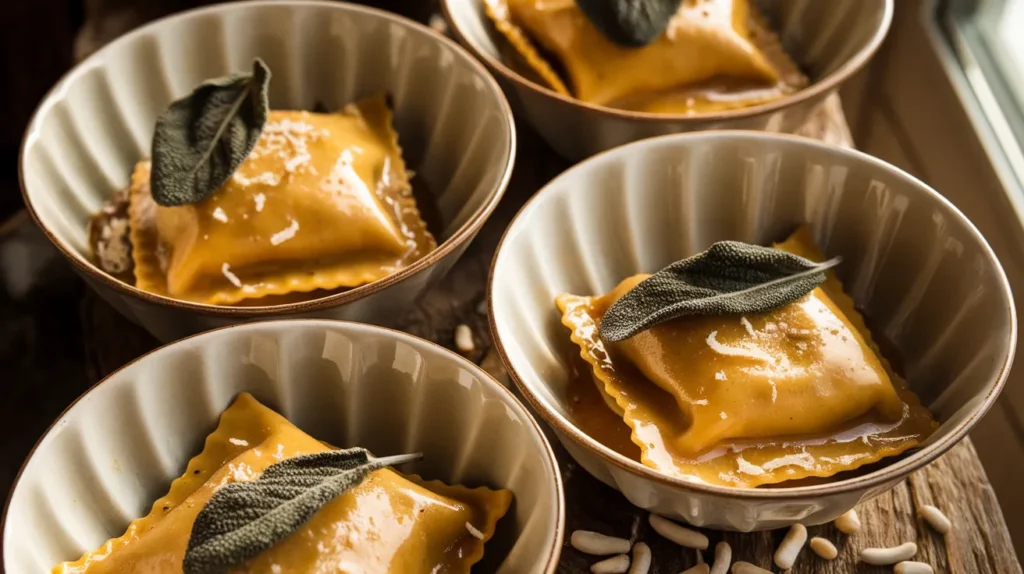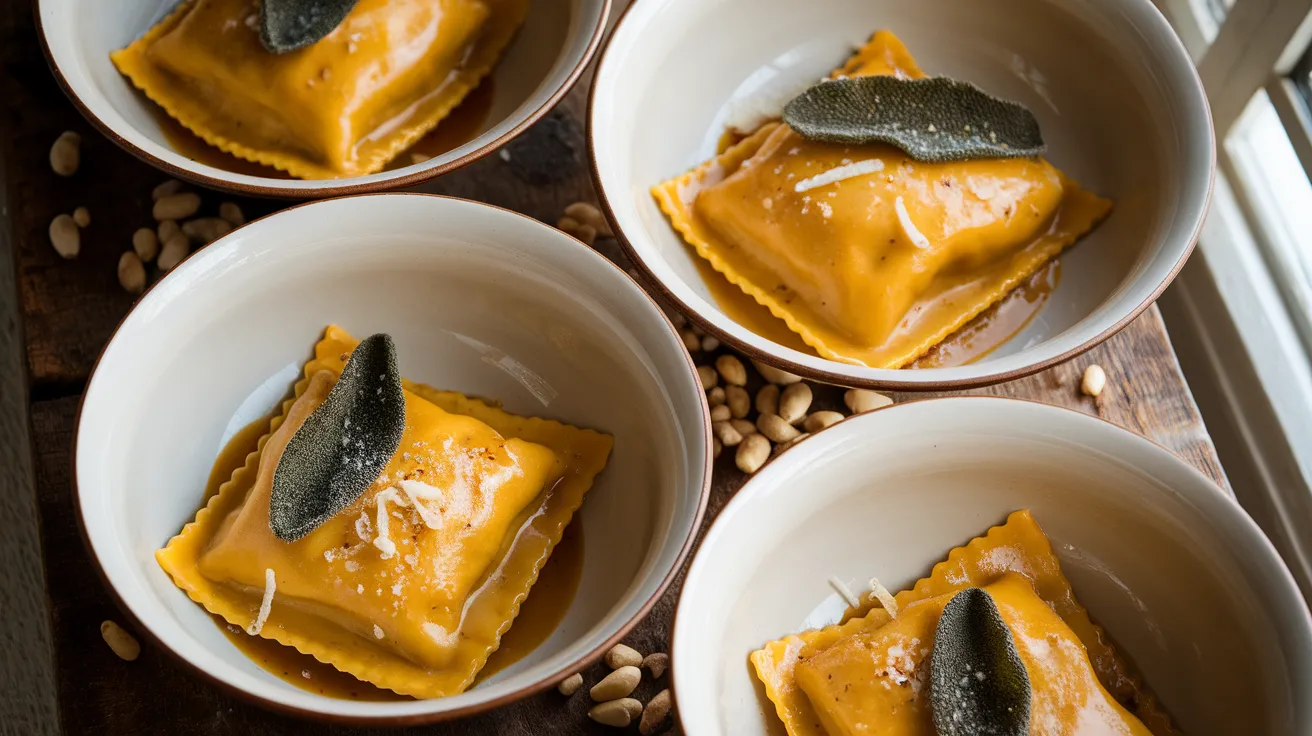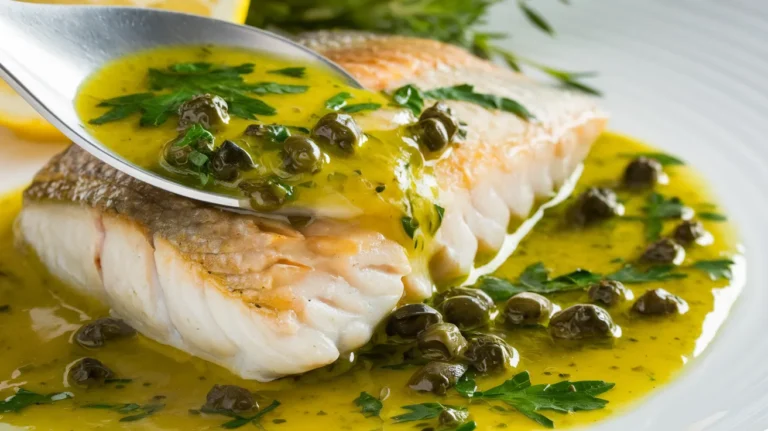This silky brown butter sage sauce for butternut squash ravioli creates restaurant-quality results at home with just a few simple ingredients. The nutty richness of browned butter paired with crispy sage leaves perfectly complements sweet butternut squash filling, while cream adds luxurious body that coats each tender ravioli. This foolproof sauce for butternut squash ravioli transforms ordinary pasta night into an elegant dining experience.
SERVES: 4 | PREP: 15 MIN | COOK: 12 MIN | TOTAL: 27 MIN
Ingredients
For the Brown Butter Sage Sauce
| Ingredient | Amount |
|---|---|
| Unsalted butter | 8 tablespoons (1 stick) |
| Fresh sage leaves | 20-25 leaves |
| Heavy cream | ¼ cup |
| Freshly grated Parmesan cheese | ½ cup |
| Fresh lemon juice | 1 tablespoon |
| Salt | ½ teaspoon |
| Black pepper | ¼ teaspoon |
| Garlic cloves, minced | 2 cloves |
For Assembly
| Ingredient | Amount |
|---|---|
| Butternut squash ravioli | 1 pound (fresh or frozen) |
| Reserved pasta water | ½ cup |
| Extra Parmesan for serving | ¼ cup |
| Toasted pine nuts (optional) | 2 tablespoons |
Step-by-Step Instructions for Sauce for Butternut Squash Ravioli
Phase 1: Prepare Your Workspace and Water (5 minutes)
- Clear your workspace completely and set out all ingredients within arm’s reach. Brown butter cooking happens quickly, so having everything ready prevents burning. Place a small bowl next to your stove for the finished sage leaves.
- Fill your largest pot with water – at least 6 quarts for 1 pound of ravioli. The pasta needs room to move freely or it will stick together and break. Add 2 tablespoons of kosher salt to the water. Taste it – it should be pleasantly salty like mild seawater.
- Cover the pot and bring to a rolling boil over high heat. This takes about 10-12 minutes depending on your stove. You’ll know it’s ready when large bubbles break the surface rapidly and continuously. Keep it covered to speed up the process and save energy.
- Set up a colander in your sink but also keep a spider strainer or large slotted spoon handy. We’ll use the strainer to gently lift ravioli from the water to prevent breaking these delicate pasta pillows.
Phase 2: Master the Brown Butter Technique (6 minutes)
- Choose a light-colored skillet – stainless steel or enameled cast iron work best. Dark pans make it impossible to see when butter turns golden brown versus burnt brown. Use a 10-12 inch pan to give the butter room to foam without overflowing.
- Cut butter into small, even pieces before adding to the cold pan. This helps it melt evenly. Place the pan over medium heat – never high heat, which burns butter before it browns properly.
- Watch the butter melt and begin to foam – this takes about 2-3 minutes. The foam is water evaporating from the butter. Swirl the pan gently every 30 seconds to ensure even heating. Don’t stir with a spoon, which can splash hot butter.
- Listen for the change in sound – the violent bubbling will calm down as water evaporates. Now watch carefully for color changes. The butter will go from yellow to golden to light brown. This crucial step takes 2-3 more minutes.
- Look for golden brown specks at the bottom of the pan and smell for a nutty, almost popcorn-like aroma. The moment you see light brown color and smell that nutty fragrance, immediately add the sage leaves. Don’t wait – brown butter becomes burnt butter in seconds.
Phase 3: Add Aromatics and Create the Base (2 minutes)
- Drop sage leaves into the hot brown butter immediately – they’ll sizzle dramatically and curl up. This is normal and wonderful. Use tongs or a fork to flip them after 15-20 seconds. They’re done when they stop bubbling vigorously and turn a darker green.
- Remove crispy sage leaves with tongs and place them on a paper towel. Sprinkle with a pinch of salt immediately while they’re hot. These will be your garnish, so keep them safe from curious fingers.
- Add minced garlic to the brown butter and stir constantly for 30 seconds. The residual heat will cook the garlic perfectly without burning it. You’ll smell the garlic become fragrant – that’s your cue to move to the next step.
- Remove pan from heat completely before adding cream. This prevents the cream from curdling or spattering. Pour cream in slowly while whisking constantly. The mixture will bubble and foam vigorously at first – this is normal.
Phase 4: Cook the Ravioli Like a Pro (4 minutes)
- Test your water with one ravioli first if you’re nervous about timing. Fresh ravioli typically takes 2-3 minutes and will float when done. Frozen ravioli needs 4-5 minutes and also floats when ready.
- Add all ravioli to boiling water gently – don’t dump them in. Lower each one carefully or they might break from the impact. Stir very gently once with a wooden spoon to prevent sticking.
- Set a timer immediately – overcooked ravioli becomes mushy and breaks apart. While they cook, place a large measuring cup near the stove. You’ll need to reserve pasta water before draining.
- Scoop out ½ cup of pasta cooking water about 1 minute before the ravioli finish cooking. This starchy, salty water is liquid gold for making silky sauces. Set it aside within easy reach.
- Test doneness by lifting one ravioli with a slotted spoon. It should be tender when pressed gently with a fork but still have some firmness. If it feels mushy, they’re overcooked.
Phase 5: Combine and Finish Your Sauce for Butternut Squash Ravioli (5 minutes)
- Drain ravioli using a spider strainer or large slotted spoon – never pour them through a colander, which can break them. Transfer them directly to the skillet with your brown butter sauce.
- Return the skillet to the lowest heat setting on your stove. High heat will break the cream sauce and make it look curdled and unappetizing.
- Add ravioli to the sauce one at a time using a large spoon and pasta fork. Gently roll each ravioli in the sauce to coat completely. Move slowly and deliberately – rushed movements break delicate pasta.
- Add pasta water gradually – start with just 2 tablespoons. Swirl the pan gently to combine. The sauce should look glossy and coat the ravioli without being soupy. Add more pasta water 1 tablespoon at a time until you achieve perfect consistency.
- Season thoughtfully with salt, pepper, and lemon juice – taste as you go. The brown butter is rich, the cheese is salty, so you might need just a pinch of salt and a generous squeeze of lemon to brighten everything up.
- Add half the Parmesan cheese and toss very gently until it melts into the sauce. The residual heat will melt the cheese perfectly without making it stringy.
- Perform the final taste test – the sauce should be nutty, creamy, and well-balanced. Adjust seasoning if needed, then remove from heat immediately.
Phase 6: Plate and Serve (2 minutes)
- Warm your serving bowls by rinsing them with hot water and drying quickly. Cold bowls will cause the butter sauce to solidify too quickly.
- Divide ravioli among warmed bowls using a large spoon and fork. Pour any remaining sauce over the top, making sure each serving gets an equal amount.
- Top with reserved crispy sage leaves – break larger ones into pieces for even distribution. Sprinkle remaining Parmesan cheese over each bowl and add toasted pine nuts if using.
- Serve immediately while the sauce is still glossy and hot. This sauce for butternut squash ravioli waits for no one – it’s best enjoyed within minutes of completion.
Chef’s Notes for Perfect Sauce for Butternut Squash Ravioli
• Brown butter temperature is everything – medium heat only, and never walk away during the browning process. The difference between perfect and burnt is about 15 seconds. • Fresh sage makes all the difference in this sauce for butternut squash ravioli because dried sage becomes bitter and harsh when fried at high temperatures. • Pasta water is your secret weapon – those natural starches help bind the sauce to each ravioli and create restaurant-quality consistency. • Room temperature ingredients work faster – take your cream and butter out 30 minutes before cooking for more even results.
Nutrition Information (Per Serving)
- Calories: 485
- Protein: 18g
- Carbohydrates: 42g
- Fat: 28g
- Fiber: 3g
- Sodium: 680mg
Creative Variations for Your Butternut Squash Ravioli Sauce
Mushroom Brown Butter Sauce
Sauté ½ pound sliced wild mushrooms until golden before starting your brown butter. This earthy variation adds wonderful depth to complement the sweet squash filling.
Spicy Sage Brown Butter Sauce
Add ¼ teaspoon red pepper flakes with the garlic for gentle warmth that enhances rather than overpowers the delicate butternut flavors.
Walnut Brown Butter Sauce
Toast ¼ cup chopped walnuts in the brown butter before adding sage leaves. The nuts add wonderful texture and complement fall flavors, just like a perfectly balanced sauce for green beans enhances seasonal vegetables.
Pancetta Sage Sauce
Cook 2 ounces diced pancetta until crispy before starting the brown butter process. The smoky, salty pork creates an irresistible contrast with sweet butternut squash.
Storage & Reheating Your Sauce for Butternut Squash Ravioli
Refrigerator Storage: Store leftover sauced ravioli in an airtight container for up to 2 days. The sauce will solidify but can be restored.
Gentle Reheating Method: Never use the microwave, which makes ravioli rubbery. Instead, add 2-3 tablespoons of cream or milk to a large skillet over low heat. Add cold ravioli and toss very gently until warmed through, about 4-5 minutes.
Make-Ahead Strategy: Prepare the brown butter sage sauce up to 2 hours in advance. Keep it at room temperature and warm gently before combining with freshly cooked ravioli.
Freezing Reality: This delicate sauce doesn’t freeze well once assembled, as the cream separates and the ravioli becomes mushy when thawed.

Troubleshooting Your Butternut Squash Ravioli Sauce
Problem: Brown butter sauce looks separated, greasy, or broken Solution: Remove from heat immediately and add hot pasta water one tablespoon at a time while whisking vigorously. The starch will help re-emulsify the sauce.
Problem: Sage leaves are burning black instead of crisping golden-green Solution: Your heat is too high. Remove the burnt leaves, lower heat to medium-low, and start with fresh sage. Burnt sage tastes bitter and ruins the sauce.
Problem: Ravioli keep breaking during cooking or tossing Solution: Use more water, handle more gently, and check if they’re overcooked. Fresh ravioli should be al dente, not mushy. Use a larger pot next time.
Problem: The sauce is too thick and won’t coat the pasta properly Solution: Add reserved pasta water gradually while tossing gently. The starches will create a silky consistency that clings to each ravioli perfectly.
Problem: Brown butter tastes acrid or bitter instead of nutty Solution: You’ve burnt it – there’s no saving burnt butter. Start over with fresh butter and use medium heat only.
Equipment Essentials
• Large heavy-bottomed pot (6-8 quarts) for cooking pasta without crowding • Light-colored skillet (10-12 inch) to monitor butter color changes accurately
• Spider strainer or large slotted spoon for gentle ravioli handling • Wooden spoon for stirring without scratching or breaking pasta • Small measuring cup for reserving pasta water • Microplane grater for fresh Parmesan cheese
Complete Shopping List
Dairy Section
- Unsalted butter (1 stick needed)
- Heavy cream (small container)
- Fresh Parmesan cheese (block for grating)
Produce Section
- Fresh sage (1 package)
- Fresh lemons (1 lemon)
- Garlic bulb (2 cloves needed)
Pasta/Italian Section
- Butternut squash ravioli (1 pound)
- Pine nuts (optional, small bag)
Pantry Staples
- Kosher salt and black pepper
Success Secrets for the Best Sauce for Butternut Squash Ravioli
- Always start with room temperature butter – it browns more evenly than cold butter and gives you better control over the browning process.
- Use your senses, not just timers – watch for color changes, listen for sound changes, and smell for that distinctive nutty aroma that signals perfect brown butter.
- Practice the mise en place method – have every single ingredient measured and within arm’s reach before you start cooking. Brown butter waits for no one.
- Taste and adjust at every step – the balance between rich butter, salty cheese, and bright lemon should be harmonious. Trust your palate over rigid measurements.
- Serve immediately in warmed bowls – this sauce for butternut squash ravioli is at its absolute best when enjoyed hot, creating the same satisfying experience as a expertly prepared sauce for brussel sprouts that elevates simple ingredients into something memorable.




